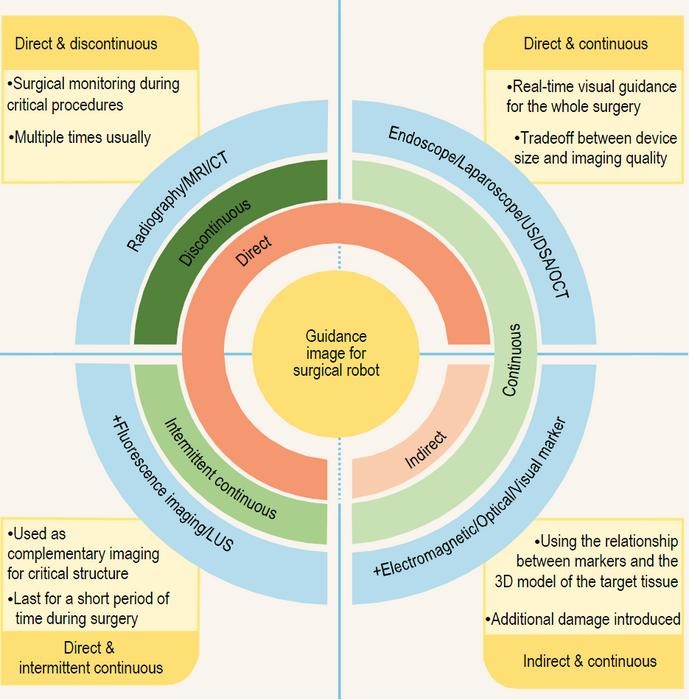Advances in Image-Guided Methods Enabling Intelligent Surgical Robots for Precise Procedures
|
By HospiMedica International staff writers Posted on 11 Jul 2024 |

Traditional image-guided methods often depend on stationary equipment within the operating room, while modern surgical robots are equipped to acquire and process high-precision images in real time during surgeries. This capability provides intuitive guidance for operations. Through the use of algorithms for data augmentation, target segmentation, and instrument tracking, these robots can quickly and accurately understand the surgical environment and adapt their functions accordingly. This enhances both the efficiency and precision of surgical procedures. Now, an online review paper published in the National Science Review has summarized the latest developments in image-guided methodologies for surgical robots, highlighting how these innovations have made surgical robots smarter and more effective in clinical settings, thus broadening the scope for precise surgical interventions.
There have been notable advancements in the deployment of surgical robots for minimally invasive surgeries. Over the years, thousands of these systems have been implemented in hospitals globally, undertaking millions of procedures. By integrating sensing, control, and execution mechanisms, surgical robots aid surgeons in conducting operations that are both accurate and efficient, which helps reduce surgical trauma, lessen postoperative pain, and shorten recovery periods. The ability of these systems to sense their environment is essential for achieving a high level of autonomy and intelligent functioning, with image processing technology being at the core of this environmental awareness.
The paper, titled "Advances of Surgical Robotics: Image-Guided Classification and Application," by Professor Lihai Zhang from the Orthopedics Department of Chinese PLA General Hospital (Beijing, China), introduces a novel classification system for navigational images used by surgical robots. This system organizes images based on data acquisition methods into direct and indirect categories, and by target tracking methods into continuous, intermittent continuous, and non-continuous. This framework divides the primary characteristics and potential applications of each category, offering a foundation for differentiating various clinical surgical robot systems and general patterns in their use of navigational images. This classification aims to guide the development of more sophisticated surgical robot systems.
Despite achieving significant progress, the field of image-guided surgical robotics still encounters numerous challenges. Future research will focus on areas such as image enhancement, surgical scene reconstruction, high-fidelity surgical simulation, intelligent planning, multimodal image registration, accurate localization for deformable tissues, and augmented reality-enhanced navigation. The review concludes with a forward-looking perspective on the evolution of surgical robot technology, aiming to extend and surpass human surgical capabilities through enhanced intelligence and autonomy in surgical robots.
Related Links:
Chinese PLA General Hospital
Latest Surgical Techniques News
- Intravascular Imaging for Guiding Stent Implantation Ensures Safer Stenting Procedures
- World's First AI Surgical Guidance Platform Allows Surgeons to Measure Success in Real-Time
- AI-Generated Synthetic Scarred Hearts Aid Atrial Fibrillation Treatment
- New Class of Bioadhesives to Connect Human Tissues to Long-Term Medical Implants
- New Transcatheter Valve Found Safe and Effective for Treating Aortic Regurgitation
- Minimally Invasive Valve Repair Reduces Hospitalizations in Severe Tricuspid Regurgitation Patients
- Tiny Robotic Tools Powered by Magnetic Fields to Enable Minimally Invasive Brain Surgery
- Magnetic Tweezers Make Robotic Surgery Safer and More Precise
- AI-Powered Surgical Planning Tool Improves Pre-Op Planning
- Novel Sensing System Restores Missing Sense of Touch in Minimally Invasive Surgery
- Headset-Based AR Navigation System Improves EVD Placement
- Higher Electrode Density Improves Epilepsy Surgery by Pinpointing Where Seizures Begin
- Open-Source Tool Optimizes Placement of Visual Brain Implants
- Easy-To-Apply Gel Could Prevent Formation of Post-Surgical Abdominal Adhesions
- Groundbreaking Leadless Pacemaker to Prevent Invasive Surgeries for Children
- Spectroscopy Technique Improves Surgery for Pediatric Epilepsy Patients
Channels
Critical Care
view channel
Ingestible Smart Capsule for Chemical Sensing in the Gut Moves Closer to Market
Intestinal gases are associated with several health conditions, including colon cancer, irritable bowel syndrome, and inflammatory bowel disease, and they have the potential to serve as crucial biomarkers... Read moreNovel Cannula Delivery System Enables Targeted Delivery of Imaging Agents and Drugs
Multiphoton microscopy has become an invaluable tool in neuroscience, allowing researchers to observe brain activity in real time with high-resolution imaging. A crucial aspect of many multiphoton microscopy... Read more
Novel Intrabronchial Method Delivers Cell Therapies in Critically Ill Patients on External Lung Support
Until now, administering cell therapies to patients on extracorporeal membrane oxygenation (ECMO)—a life-support system typically used for severe lung failure—has been nearly impossible.... Read morePatient Care
view channel
Portable Biosensor Platform to Reduce Hospital-Acquired Infections
Approximately 4 million patients in the European Union acquire healthcare-associated infections (HAIs) or nosocomial infections each year, with around 37,000 deaths directly resulting from these infections,... Read moreFirst-Of-Its-Kind Portable Germicidal Light Technology Disinfects High-Touch Clinical Surfaces in Seconds
Reducing healthcare-acquired infections (HAIs) remains a pressing issue within global healthcare systems. In the United States alone, 1.7 million patients contract HAIs annually, leading to approximately... Read more
Surgical Capacity Optimization Solution Helps Hospitals Boost OR Utilization
An innovative solution has the capability to transform surgical capacity utilization by targeting the root cause of surgical block time inefficiencies. Fujitsu Limited’s (Tokyo, Japan) Surgical Capacity... Read more
Game-Changing Innovation in Surgical Instrument Sterilization Significantly Improves OR Throughput
A groundbreaking innovation enables hospitals to significantly improve instrument processing time and throughput in operating rooms (ORs) and sterile processing departments. Turbett Surgical, Inc.... Read moreHealth IT
view channel
Printable Molecule-Selective Nanoparticles Enable Mass Production of Wearable Biosensors
The future of medicine is likely to focus on the personalization of healthcare—understanding exactly what an individual requires and delivering the appropriate combination of nutrients, metabolites, and... Read more
Smartwatches Could Detect Congestive Heart Failure
Diagnosing congestive heart failure (CHF) typically requires expensive and time-consuming imaging techniques like echocardiography, also known as cardiac ultrasound. Previously, detecting CHF by analyzing... Read moreBusiness
view channel
Expanded Collaboration to Transform OR Technology Through AI and Automation
The expansion of an existing collaboration between three leading companies aims to develop artificial intelligence (AI)-driven solutions for smart operating rooms with sophisticated monitoring and automation.... Read more
















